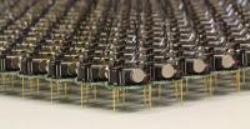A team of engineers at the Harvard University have developed tiny robots called Kilobots, which are capable of interacting amongst themselves and working as a team. These robots are the size of a bug and move on three legs, which are the size of a toothpick.
 kilobots
kilobots
This new development is a licensed technology, which can be used for testing algorithms collectively on even thousands of tiny robots. A technical report published at Harvard provides information on a team of 25 machines, which exhibit swarming behaviour like formation control, synchronization and foraging. Once these machines started operating, they continued their operation without any human aid.
These robots were created by a team of Self-Organising Systems Research Group led by Radhika Nagpal. The other members of the team are a postdoctoral student at SEAS and a fellow of the SEAS and Wyss Institute. The development of these Kilobots will be useful for future development of multi-robot systems, which are run by advanced algorithms for coordinated action amongst tens to thousands of robots. The research team drew the inspiration for the design of these robots from social insects like ants or bees, which work as a team to find food sources even in complex environments. Currently computer simulation is being used for testing the algorithms on a few dozen robots. Some of the potential applications of these Kilobots are finding survivors through rubble in the tunnel, monitoring and removal of contaminants and assembling themselves to support structures in a collapsed building. They could be deployed in dangerous environments for assisting crops in pollination or undertaking risky search operations. Currently, the research team is using these robots for testing purposes for understanding collective behaviour.